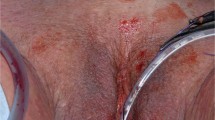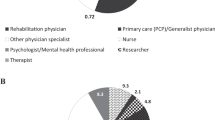Abstract
Study design
Retrospective cohort study.
Objectives
To assess the effectiveness and complications of treatment for neurogenic stress urinary incontinence (nSUI) by Adjustable Continence Therapy (ACT™ and ProACT™).
Setting
France.
Methods
A retrospective multicentre study of consecutive patients with neurological pathologies treated for nSUI with ACT balloons.
Results
From January 2001 to January 2013, 102 patients were implanted. Mean (SD) age at implantation was 48.4 (16.5) years. Patients were followed-up for a mean 2.7 (2.3) years. After implantation, 5.9% of patients were totally continent, 51.2% had an improvement in symptoms of at least 50% (including 14.6% with improvements of at least 90%), and 48.8% had improvements of < 50%, including 7.3% of treatment failures. Complications occurred in 70 patients (120 balloons): 21 balloon infections, 34 migrations, 18 device failures, 28 urethral erosions and 28 cutaneous erosions. The procedure was ineffective for 35 patients. Twenty patients underwent permanent explantation. The rate of migrations was lower in patients with upper motor neuron lesion than in those with lower motor neuron lesion (p = 0.04).
Conclusions
ACT is a minimally invasive treatment for SUI related to sphincter deficiency. This is one of the first reports in a sample of patients with neurological disorders implanted by multiple surgeons. ACT could be a less invasive, appropriate alternative to artificial urinary sphincters. However, it is associated with frequent local complications which are easy to manage but that should be reduced in this challenging population.
Similar content being viewed by others
Log in or create a free account to read this content
Gain free access to this article, as well as selected content from this journal and more on nature.com
or
References
Gajewski JB, Schurch B, Hamid R, Averbeck M, Agrò EF, Dickinson T, et al. An International Continence Society (ICS) report on the terminology for adult neurogenic lower urinary tract dysfunction (ANLUTD). Neurourol Urodyn. 2018;37:1152–61.
Hamid R, Khastgir J, Arya M, Patel HR, Shah PJ. Experience of tension-free vaginal tape for the treatment of stress incontinence in females with neuropathic bladders. Spinal Cord. 2003;41:118–21.
Drake MJ, Apostolidis A, Cocci A, Emmanuel A, Gajewski JB, Harrison SC, et al. Neurogenic lower urinary tract dysfunction: Clinical management recommendations of the Neurologic Incontinence committee of the fifth International Consultation on Incontinence 2013. Neurourol Urodyn. 2016;35:657–65.
Mehnert U, Bastien L, Denys P, Cardot V, Even-Schneider A, Kocer S, et al. Treatment of neurogenic stress urinary incontinence using an adjustable continence device: 4-year followup. J Urol. 2012;188:2274–80. https://doi.org/10.1016/j.juro.2012.07.131
Ammirati E, Manassero A, Giammò A, Carone R. Management of male and female neurogenic stress urinary incontinence in spinal cord injured (SCI) patients using adjustable continence therapy. Urologia. 2017;84:165–8.
Kocjancic E, Crivellaro S, Ranzoni S, Bonvini D, Gontero P, Frea B. Adjustable Continence Therapy for the treatment of male stress urinary incontinence: a single-centre study. Scand J Urol Nephrol. 2007;41:324–8.
Chartier-Kastler E, Ayoub N, Richard F, Ruffion A. Prosthetic surgery for stress urinary incontinence due to neurogenic sphincter incompetence. Prog Urol. 2007;17:600–8.
Vayleux B, Luyckx F, Thélu S, Rigaud J, Bouchot O, Karam G, et al. Adjustable Continence Therapy in women, middle term follow-up and a new technique for balloon positioning. Prog Urol. 2010;20:520–6.
Chartier-Kastler E. ACT™ Balloons Versus Artificial Urinary Sphincter (AMS800™) for the Treatment of Female Stress Urinary Incontinence (SU-ACT). In: ClinicalTrials.gov [Internet]. Bethesda (MD): National Library of Medicine (US). 2016–[2017 Feb 19]. https://clinicaltrials.gov/ct2/show/NCT02490917. NLM Identifier: NCT02490917.
Chartier-Kastler E, Costa P, Ben Naoum K, Cour F, Le Normand L, Haab F. French multicentre prospective study of the use of ACT balloons (Uromedica, Inc., Plymouth, Min, USA; Medtronic, Minneapolis, USA) for the treatment of female stress urinary incontinence. Prog Urol. 2007;17:1372–7.
Gregori A, Romanò AL, Scieri F, Pietrantuono F, Incarbone GP, Salvaggio A, et al. Transrectal ultrasound-guided implantation of Adjustable Continence Therapy (ProACT): surgical technique and clinical results after a mean follow-up of 2 years. Eur Urol. 2010;57:430–6.
Kirshblum SC, Burns SP, Biering-Sorensen F, Donovan W, Graves DE, Jha A, et al. International standards for neurological classification of spinal cord injury (revised 2011). J Spinal Cord Med. 2011;34:535–46.
Trigo-Rocha F, Gomes CM, Pompeo ACL, Lucon AM, Arap S. Prospective study evaluating efficacy and safety of Adjustable Continence Therapy (ProACT) for post radical prostatectomy urinary incontinence. Urology. 2006;67:965–9.
Aboseif SR, Franke EI, Nash SD, Slutsky JN, Baum NH, Tu le M, et al. The adjustable continence therapy system for recurrent female stress urinary incontinence: 1-year results of the North America Clinical Study Group. J Urol. 2009;181:2187–91.
Gilling PJ, Bell DF, Wilson LC, Westenberg AM, Reuther R, Fraundorfer MR. An adjustable continence therapy device for treating incontinence after prostatectomy: a minimum 2-year follow-up. BJU Int. 2008;102:1426–30.
Hübner WA, Schlarp OM. Adjustable continence therapy (ProACT): evolution of the surgical technique and comparison of the original 50 patients with the most recent 50 patients at a single centre. Eur Urol. 2007;52:680–6.
Uromedica. ProACT Therapy for the Treatment of Stress Urinary Incontinence in Males (ProACT). In: ClinicalTrials.gov [Internet]. Bethesda (MD): National Library of Medicine (US). 2006–[2017 Mar 5]. https://clinicaltrials.gov/ct2/show/NCT00277095. NLM Identifier: NCT00277095.
Aboseif SR, Sassani P, Franke EI, Nash SD, Slutsky JN, Baum NH, et al. Treatment of moderate to severe female stress urinary incontinence with the adjustable continence therapy (ACT) device after failed surgical repair. World J Urol. 2011;29:249–53.
Drake MJ. Neurologic urinary and faecal incontinence, in Incontinence, In: Abrams P, Cardozo L, Khoury S, Wein A (eds), Incontinence, 5th edn (ICUD-EAU, 2013), pp 827–1000.
Author contributions
BPV conceptualized the study. All authors were involved in designed study. LLN, ECK, PD, XG and PG prepared data analyses. YR, BPV and ECK coordinated data analyses and interpretations. YR analysed the data. All authors assisted overall interpretation and contextualization. YR, BPV wrote the first draft of the manuscript. All authors critically reviewed and approved manuscript.
Author information
Authors and Affiliations
Corresponding author
Ethics declarations
Conflict of interest
EC-K has served as consultant for Uromedica. Remaining authors declare that they have no conflict of interest.
Rights and permissions
About this article
Cite this article
Ronzi, Y., Le Normand, L., Chartier-Kastler, E. et al. Neurogenic stress urinary incontinence: is there a place for Adjustable Continence Therapy (ACT™ and ProACT™, Uromedica, Plymouth, MN, USA)? A retrospective multicenter study. Spinal Cord 57, 388–395 (2019). https://doi.org/10.1038/s41393-018-0219-3
Received:
Revised:
Accepted:
Published:
Issue date:
DOI: https://doi.org/10.1038/s41393-018-0219-3
This article is cited by
-
Management of Neurogenic Stress Urinary Incontinence: An Updated Review
Current Bladder Dysfunction Reports (2024)
-
Initial experience with ACT™ periurethral adjustable balloons to treat urinary incontinence due to intrinsic sphincter deficiency in the pediatric population
World Journal of Urology (2023)
-
Management of stress urinary incontinence in female patients with spinal cord injury by autologous fascial sling: time for a revival?
Spinal Cord Series and Cases (2022)



